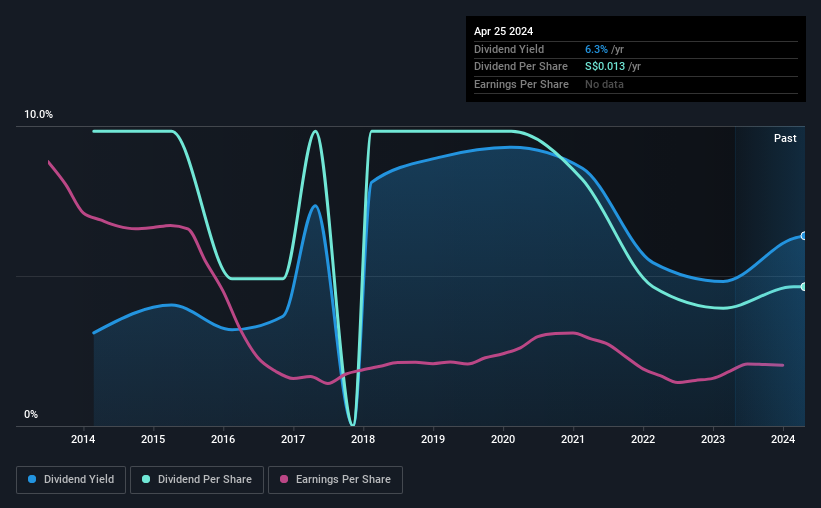Overseas Education Limited (SGX:RQ1) is about to trade ex-dividend in the next 3 days. The ex-dividend date is one business day before a company’s record date, which is the date on which the company determines which shareholders are entitled to receive a dividend. The ex-dividend date is an important date to be aware of as any purchase of the stock made on or after this date might mean a late settlement that doesn’t show on the record date. Accordingly, Overseas Education investors that purchase the stock on or after the 30th of April will not receive the dividend, which will be paid on the 10th of May.
The company’s upcoming dividend is S$0.013 a share, following on from the last 12 months, when the company distributed a total of S$0.013 per share to shareholders. Based on the last year’s worth of payments, Overseas Education stock has a trailing yield of around 6.3% on the current share price of S$0.205. Dividends are a major contributor to investment returns for long term holders, but only if the dividend continues to be paid. So we need to check whether the dividend payments are covered, and if earnings are growing.
Check out our latest analysis for Overseas Education
Dividends are usually paid out of company profits, so if a company pays out more than it earned then its dividend is usually at greater risk of being cut. Its dividend payout ratio is 80% of profit, which means the company is paying out a majority of its earnings. The relatively limited profit reinvestment could slow the rate of future earnings growth. It could become a concern if earnings started to decline. Yet cash flow is typically more important than profit for assessing dividend sustainability, so we should always check if the company generated enough cash to afford its dividend. What’s good is that dividends were well covered by free cash flow, with the company paying out 18% of its cash flow last year.
It’s positive to see that Overseas Education’s dividend is covered by both profits and cash flow, since this is generally a sign that the dividend is sustainable, and a lower payout ratio usually suggests a greater margin of safety before the dividend gets cut.
Click here to see how much of its profit Overseas Education paid out over the last 12 months.
Have Earnings And Dividends Been Growing?
Companies that aren’t growing their earnings can still be valuable, but it is even more important to assess the sustainability of the dividend if it looks like the company will struggle to grow. If earnings decline and the company is forced to cut its dividend, investors could watch the value of their investment go up in smoke. It’s not encouraging to see that Overseas Education’s earnings are effectively flat over the past five years. Better than seeing them fall off a cliff, for sure, but the best dividend stocks grow their earnings meaningfully over the long run.
Many investors will assess a company’s dividend performance by evaluating how much the dividend payments have changed over time. Overseas Education’s dividend payments per share have declined at 7.2% per year on average over the past 10 years, which is uninspiring.
The Bottom Line
From a dividend perspective, should investors buy or avoid Overseas Education? The payout ratios appear reasonably conservative, which implies the dividend may be somewhat sustainable. Still, with earnings basically flat, Overseas Education doesn’t stand out from a dividend perspective. It might be worth researching if the company is reinvesting in growth projects that could grow earnings and dividends in the future, but for now we’re not all that optimistic on its dividend prospects.
With that being said, if dividends aren’t your biggest concern with Overseas Education, you should know about the other risks facing this business. For example, we’ve found 3 warning signs for Overseas Education (1 is significant!) that deserve your attention before investing in the shares.
Generally, we wouldn’t recommend just buying the first dividend stock you see. Here’s a curated list of interesting stocks that are strong dividend payers.
Have feedback on this article? Concerned about the content? Get in touch with us directly. Alternatively, email editorial-team (at) simplywallst.com.
This article by Simply Wall St is general in nature. We provide commentary based on historical data and analyst forecasts only using an unbiased methodology and our articles are not intended to be financial advice. It does not constitute a recommendation to buy or sell any stock, and does not take account of your objectives, or your financial situation. We aim to bring you long-term focused analysis driven by fundamental data. Note that our analysis may not factor in the latest price-sensitive company announcements or qualitative material. Simply Wall St has no position in any stocks mentioned.







